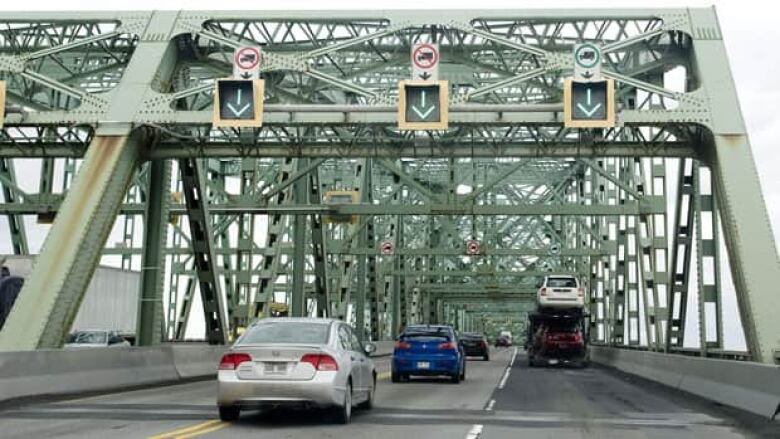Champlain Bridge repairs to cost millions, fix nothing

The Conservative government has releaseda long-awaited report on Montreal's deteriorating Champlain Bridge, completing a swift, 24-hour about-face on the contentious issue of the city's aging road infrastructure.
The86-page report says that simply prolonging the life of the crumbling Champlain Bridge would cost as much as $25 million a year for the next decade and that still wouldn't produce a long-term fix.
The document examines several replacement options for the 49-year-old bridge, one of Canada's busiest spans.
Replacement options include a new bridge or tunnel. And the report recommendsboth options include a dedicated public transit lane in either direction.
A light rail transit route could be built at reasonable cost on Champlain's current ice bridge, the report said. (Theice bridge runs parallel to the Champlain Bridge about 300 metres upstream. It was built as an ice-jam control structure in the mid-1960s. It is used now as a bike path.)
The report also suggests a new span be limited to three lanes in either direction. Adding any more lanes than that will exacerbate congestion, and all stakeholders consulted are opposed to a bigger bridge.
Plans for the bridge must be co-ordinated with other infrastructure projects in Montreal, including the Bonaventure Expressway plan (Montreal wants to downgrade it to a boulevard).
The Bonaventure project will increase bridge traffic, according to the bridge report.
The estimated cost for a new bridge is $1.282 billion, less than the estimated cost for a new tunnel ($1.907 billion.)
The study concludesthat digging a tunnel would include numerous benefits, despite the higher cost.
The study's release comes just one day after the Conservative government said it would not make it public.
Ottawa hesitant to release report
Federal Transport Minister Denis Lebel said Tuesday he didn't want people to worry unnecessarily.
"If we made the report public, it might be misinterpreted by people who don't understand the subject," said Lebel. "It might create unnecessary fears. It's not time to create public insecurity."
Lebel said what the public needs to know is that the bridge repairs will be done.
His comments had the exact opposite effect and the Champlain Bridge immediately became a top news story in Quebec, with Lebel's comments fuelling local concern about the safety of the structure.
Hoang Mai, MP for Brossard-La Prairie, the riding on the south end of the bridge, said the government's initial refusal to release the report was unacceptable.
"I believe that it's a bit arrogant and that it undermines the intelligence and it shows the lack of transparency that the goverment is guilty of right now," he told CBC News.
Mai said people already have reason to be afraid, pointing to a earlier report already made publicthat warned that the bridge is in danger of collapsing if an earthquake hit the area.
Champlain problems documented
The bridge has been riddled with problems this summer. Last week, authorities shut down two island-bound lanes because of a large pothole, which led to traffic chaos during rush hour.
Last April, a Montreal-area coalition of mayors, business leaders and interest groups launched an online petition calling for the bridge to be replaced.
The federal government has already said it would spend $158-million on bridge repairs, but isn't ready to replace the Champlain Bridge.
Quebec's Liberal government isalready taking steps to prepare the ground for a new Champlain Bridge.
The bridge is Canada's busiest span, accommodating 60 million cars annually since it was built in 1962.
Don't know yet what caused failure
What we do know about the bridge at this point is that it fell well short of its intended design life, said Barry Steinberg, CEO of Consulting Engineers of Ontario,in an interview with CBCs Lang & OLeary Exchange.
But he cautions that engineers dont know why the bridge failed it could be anything from poor construction to engineering to maintenance.
Steinberg said municipalities across Canada are struggling with falling bridges, broken roads, and outdated public transit systems. His engineering association estimates there is an infrastructure deficit of $160 billion across Canada.
Its going to take long-term planning and long-term investment to start fixing the problem, he said, urging cities to work with federal and provincial governments to find funding tools.
If they are public assets, the public is ultimately going to pay for them. Its a matter of the mechanisms that are used whether its public-private partnerships or direct funding, Steinberg said, adding that there has got to be a range of solutions to raise funding for different kinds of projects.
Study highlights:
- The study was commissioned to examine the need for a new bridge or whether the current span can be repaired.
- The cost of repairing the current Champlain Bridge will increase over time, from $18 million per year to $25 million annually.
- The bridge's structure means that deterioration of the concrete deck affects the girder flanges, which are hard to repair.
- Repairing the current bridge won't improve its resilience against earthquakes.
- The bridge handles 57 million crossings per year (2009 figure).
- Daily traffic is 156,000 vehicles, 12,000 trucks, 1,900 buses.
- Morning commuter traffic is 6,200 vehicles per hour.
- More than half of bridge traffic is made up of vehicles travelling from Longueuil to downtown Montreal, or vice-versa.
- Bridge operates constantly at level F, or "forced flow congestion."
- Number of trips by bus equals the number of car trips.
- During morning rush hour, there are more people on the bridge bus lane than on the yellow metro line.
- Bus use on the span is expected to increase 16 per cent in the next five years.
With files from the Canadian Press












_(720p).jpg)


 OFFICIAL HD MUSIC VIDEO.jpg)
.jpg)



























































































